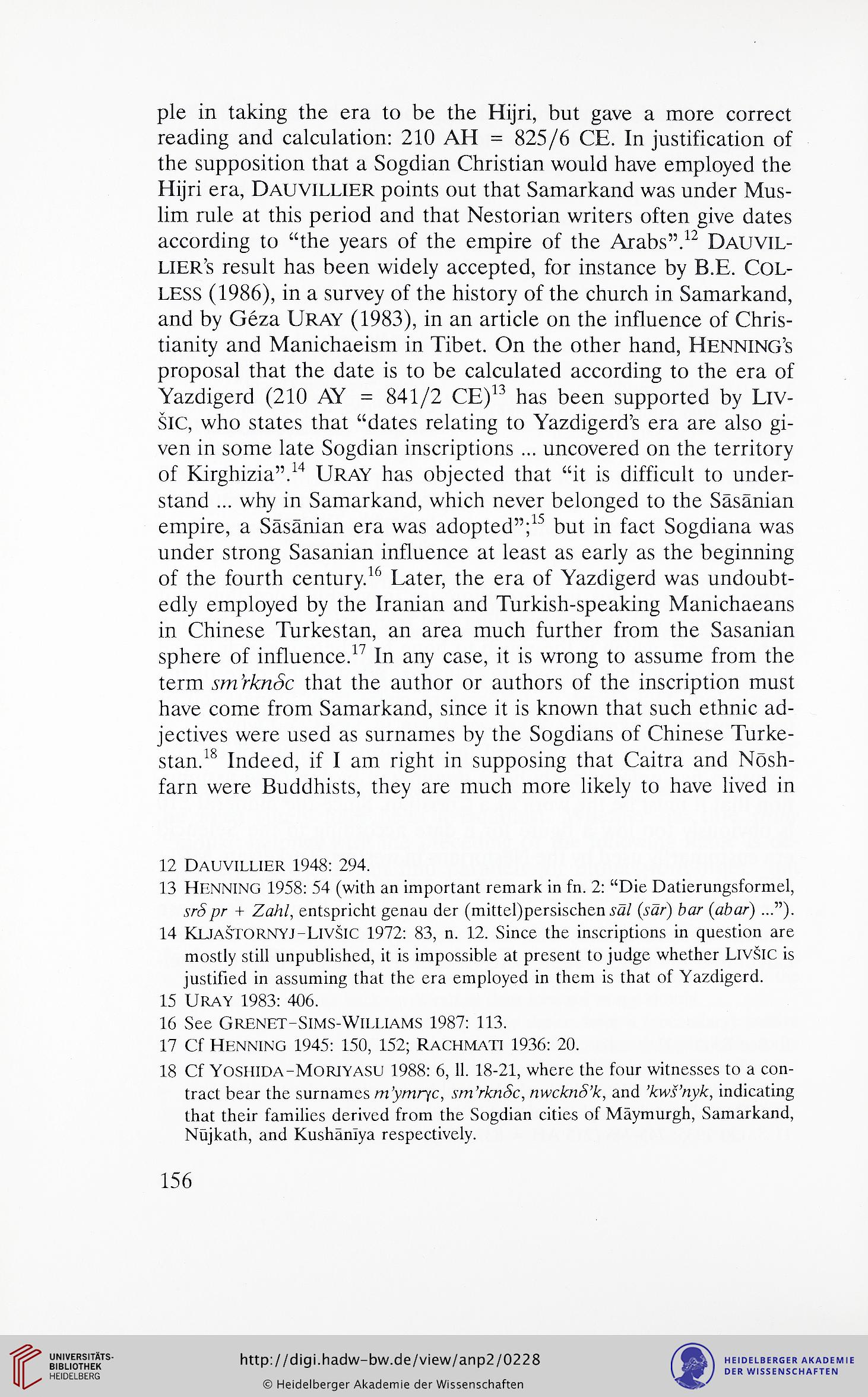pie in taking the era to be the Hijri, but gave a more correct
reading and calculation: 210 AH = 825/6 CE. In justification of
the supposition that a Sogdian Christian would have employed the
Hijri era, DAUVILLIER points out that Samarkand was under Mus-
lim rule at this period and that Nestorian writers often give dates
according to "the years of the empire of the Arabs".^ DAUVIL-
LiER's result has been widely accepted, for instance by B.E. COL-
LESS (1986), in a survey of the history of the church in Samarkand,
and by Géza URAY (1983), in an article on the influence of Chris-
tianity and Manichaeism in Tibet. On the other hand, HENNING S
proposal that the date is to be calculated according to the era of
Yazdigerd (210 AY = 841/2 CE)^ has been supported by Liv-
SIC, who states that "dates relating to Yazdigerd's era are also gi-
ven in some late Sogdian inscriptions ... uncovered on the territory
of Kirghizia".^ URAY has objected that "it is difficult to under-
stand ... why in Samarkand, which never belonged to the Säsänian
empire, a Säsänian era was adopted";^ but in fact Sogdiana was
under strong Sasanian influence at least as early as the beginning
of the fourth century/*' Later, the era of Yazdigerd was undoubt-
edly employed by the Iranian and Turkish-speaking Manichaeans
in Chinese Turkestan, an area much further from the Sasanian
sphere of influence.^ In any case, it is wrong to assume from the
term .w? %??&* that the author or authors of the inscription must
have come from Samarkand, since it is known that such ethnic ad-
jectives were used as surnames by the Sogdians of Chinese Turke-
stan.^ Indeed, if I am right in supposing that Caitra and Nösh-
farn were Buddhists, they are much more likely to have lived in
12 DAUVILLIER 1948: 294.
13 HENNING 1958: 54 (with an important remark in fn. 2: "Die Datierungsformel,
pr + Zeh/, entspricht genau der (mittel)persischenic/ fycr) hw (cher)
14 KUASTORNYJ-LIVSIC 1972: 83, n. 12. Since the inscriptions in question are
mostly still unpublished, it is impossible at present to judge whether LIVSIC is
justified in assuming that the era employed in them is that of Yazdigerd.
15 URAY 1983: 406.
16 See GRENBT-SlMS-WlLLIAMS 1987: 113.
17 Cf HENNING 1945: 150, 152; RACHMATi 1936: 20.
18 Cf YOSHIDA-MORIYASU 1988: 6, 11. 18-21, where the four witnesses to a con-
tract bear the surnames m^rnryc, ym cwcUiYk, and TuvCcyC indicating
that their families derived from the Sogdian cities of Mäymurgh, Samarkand,
Nüjkath, and Kushânîya respectively.
156
reading and calculation: 210 AH = 825/6 CE. In justification of
the supposition that a Sogdian Christian would have employed the
Hijri era, DAUVILLIER points out that Samarkand was under Mus-
lim rule at this period and that Nestorian writers often give dates
according to "the years of the empire of the Arabs".^ DAUVIL-
LiER's result has been widely accepted, for instance by B.E. COL-
LESS (1986), in a survey of the history of the church in Samarkand,
and by Géza URAY (1983), in an article on the influence of Chris-
tianity and Manichaeism in Tibet. On the other hand, HENNING S
proposal that the date is to be calculated according to the era of
Yazdigerd (210 AY = 841/2 CE)^ has been supported by Liv-
SIC, who states that "dates relating to Yazdigerd's era are also gi-
ven in some late Sogdian inscriptions ... uncovered on the territory
of Kirghizia".^ URAY has objected that "it is difficult to under-
stand ... why in Samarkand, which never belonged to the Säsänian
empire, a Säsänian era was adopted";^ but in fact Sogdiana was
under strong Sasanian influence at least as early as the beginning
of the fourth century/*' Later, the era of Yazdigerd was undoubt-
edly employed by the Iranian and Turkish-speaking Manichaeans
in Chinese Turkestan, an area much further from the Sasanian
sphere of influence.^ In any case, it is wrong to assume from the
term .w? %??&* that the author or authors of the inscription must
have come from Samarkand, since it is known that such ethnic ad-
jectives were used as surnames by the Sogdians of Chinese Turke-
stan.^ Indeed, if I am right in supposing that Caitra and Nösh-
farn were Buddhists, they are much more likely to have lived in
12 DAUVILLIER 1948: 294.
13 HENNING 1958: 54 (with an important remark in fn. 2: "Die Datierungsformel,
pr + Zeh/, entspricht genau der (mittel)persischenic/ fycr) hw (cher)
14 KUASTORNYJ-LIVSIC 1972: 83, n. 12. Since the inscriptions in question are
mostly still unpublished, it is impossible at present to judge whether LIVSIC is
justified in assuming that the era employed in them is that of Yazdigerd.
15 URAY 1983: 406.
16 See GRENBT-SlMS-WlLLIAMS 1987: 113.
17 Cf HENNING 1945: 150, 152; RACHMATi 1936: 20.
18 Cf YOSHIDA-MORIYASU 1988: 6, 11. 18-21, where the four witnesses to a con-
tract bear the surnames m^rnryc, ym cwcUiYk, and TuvCcyC indicating
that their families derived from the Sogdian cities of Mäymurgh, Samarkand,
Nüjkath, and Kushânîya respectively.
156




